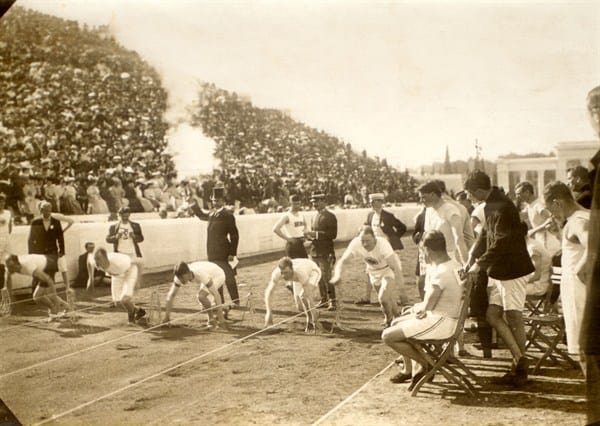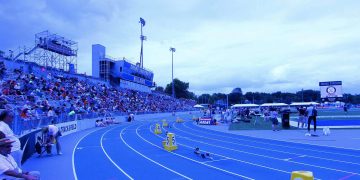Walt Murphy is one of the finest track geeks that I know. Walt does #ThisDayinTrack&FieldHistory, an excellent daily service that provides true geek stories about our sport. You can check out the service for FREE with a free one-month trial subscription! (email: WaltMurphy44@gmail.com ) for the entire daily service. We will post a few historic moments each day, beginning February 1, 2024.
by Walt Murphy’s News and Results Service (wmurphy25@aol.com), used with permission.
(c)Copyright 2024-all rights reserved. It may not be reprinted or retransmitted without permission.
This Day in Track & Field–April 6
(Olympics Reborn, John Camien, “You’re Fired”, Roy Martin, Johnny Gray, Hardee/Birthdays-Catalano, Samara, Bob Soth Arnie Sowell)
1896—The Olympic Games (April 6-15) were reborn in Athens, and the first gold medals of the Modern Era were won by Americans James Connolly in the Triple Jump (44-11 ¾ [13.71]) and Bob Garrett in the Discus (95-7 1/4/WR/29.15). Garrett would come back the next day to win the Shot Put (36-9 ¾ [11.22]) and also finish second in the Long Jump.
The day started with the Opening Ceremony, with 60,000 fans cheering as Greece’s King George I declared the Games open.
The American team, which would dominate these Games, was drawn from Princeton University and the Boston Athletic Association.
https://en.wikipedia.org/wiki/1896_Summer_Olympics
NY Times(for subscribers): https://timesmachine.nytimes.com/timesmachine/1896/04/08/105746357.html?pageNumber=4
Panathenaic Stadium—Site of the 1896 Olympics
https://en.wikipedia.org/wiki/Panathenaic_Stadium
1963–John Camien, a sophomore at Emporia State(KS) ran down Dyrol Burleson, the former American Record holder in the event, to pull off an upset win in the Mile at the Texas Relays (4:02.6-4:02.8).
Camien, a NY State champion in the 880 and Mile while at Sewanhaka H.S. on Long Island, won seven NAIA titles while at Emporia: two in cross-country (1963, 1964), three in the mile (1962, 1966, 1965), and one at 1500 meters (1964). He probably would have won more, but the NAIA didn’t sponsor an indoor championship until 1966!
George Brose of Once Upon a Time in the Vest, a sophomore at Oklahoma, took the video linked below from the infield. He also offers some other details from the meet at: https://onceuponatimeinthevest.blogspot.com/2013/02/april-1963.html (Scroll Down)
https://www.youtube.com/watch?v=1i6EtzHNSuo
Kansas Hall of Fame: https://www.kshof.org/team/john-camien
1968—Two of the top collegiate teams in the U.S. met in a dual meet, with Tennessee (77) beating Villanova (67) on the Vols’ home track in Knoxville.
Richmond Flowers (T/13.5) won the 120y-Hurdles over Erv Hall (V/13.6). Hall went on to win the silver medal in the 110m-Hurdles at the Mexico City Olympics later in the year.
Villanova’s Larry James, another future Olympic medalist, won the 440y (45.7). He won silver in the 400, gold in the 4×400 in Mexico City.
Tennessee’s Bill Skinner won the Javelin with a throw of 243-7 (74.24), and Villanova’s Dave Patrick won the 880y (1:48.6).
1973–A momentous day in the life of this track fan. It was a Friday, the day before my sister Eileen was to get married, and our house was abuzz with excitement and preparations for the big day. The phone rang, and it was my Wall Street boss telling me that my services were no longer required and that I didn’t need to report for work on Monday. He used some flimsy excuse to justify the firing, but, in reality, he had been looking for a reason to get rid of me for at least a year. He caught me off guard and I weakly protested, but to no avail. Not wanting to spoil the mood, I didn’t tell my family until after the wedding.
But let me go back to the beginning of my corporate career. After coasting through my senior year of H.S. in 1961, I anticipated doing the same when I entered Fordham that fall. But then I started realizing that I might actually have to work hard in college, and come up with things like “term papers”. That freaked me out, so I passed on one form of education for another.
My older sister Teresa worked for a Wall Street firm called DeCoppet & Doremus, and, nepotism being what it was in those days, she was able to get me a job as a filing clerk that fall. (By now, you’re probably wondering what this has to do with track & field, but I’m getting to that).
I was a very young and shy 17 when I started working, but Doremus, which was Wall Street’s version of “Animal House”, soon dragged me out of my shell. We had so much fun at that place that I couldn’t wait to go work each day (how many people can say that?), and friendships were formed that are still going strong six decades later.
This “funhouse” lasted until 1970, when word came out that we were going to merge with our competitor, Carlisle & Jacquelin (in reality, it was a takeover–by them). I was one of the “lucky” ones who was chosen to move on to the combined firm, but others, some with 20-years experience, were told on New Year’s Eve that they were out of a job.
As loose as the bosses at Doremus ran their ship (which I’m sure contributed to its downfall), the ones at Carlisle ran their’s like a Marine boot camp! A handful of us newcomers, unaccustomed to this strict environment, often voiced our displeasure, and I had more than one shouting match with the head honcho (so much for that shy teenager). And then came that fateful phone call.
Now, to the good part, that silver lining is in my personal cloud. I had been traveling to track meets around the U.S. and I had been to three Olympics with Track and Field News, but they were all planned around whatever time I could get off from work. Now, for the first time in my life, I had this open window, and I decided to take advantage of it. I had some money coming to me from my profit-sharing plan, so I decided to become a “track bum” for a while (some would say I still am).
My “Excellent Adventure” lasted 16 months and included a cross-country trip in 1973 in my bright orange Karmann (aka Kharman) Ghia, with stops in Baton Rouge (NCAA) and Bakersfield (AAU) before heading off to Europe for a series of meets involving the U.S. Junior and Senior teams.
In 1974, I started out again in my VW Ghia. Still, after driving down to Austin (NCAA) and then to Gainesville (U.S. Junior Championships), I lost all desire to drive back to California for the AAU meet. I left my car at the Gainesville airport, flew to Los Angeles, and then drove back to NY when I returned to Florida. With my cash reserves depleted and my credit card bills soaring, it was time for a reality check, so I reluctantly returned to the world of Wall Street in the fall of 1974, staying for 11 years before deciding to become a full-time “track bum” in 1985!
1984–Texas’ Einar Vilhjálmsson, a senior from Iceland, took advantage of strong winds to throw the “old” Javelin 303-2 (92.42) at the Texas Relays to set a Collegiate Record. The previous mark of 300-0 (91.44) was set by Arizona State’s Mark Murro in 1970. Vilhjálmsson went on to win his 2nd straight NCAA title in June and finished 6th at the L.A. Olympics. He also competed for Iceland at the 1988 and 1992 Olympics.
Vilhjálmsson, whose dad Vilhjálmur was the silver medalist in the Triple Jump at the 1956 Olympics, was elected President of the Icelandic Federation in September 2014.
1984/1985–Texas prep Roy “The Robot” Martin kicked off an amazing two-year stretch by winning overall MVP honors at the 1984 Texas Relays. On Friday (4-6), the junior at Roosevelt H.S. won the prep 100-meters in a wind-aided 10.14, then came back the following day (4-7) to anchor his team to fast wins in the 4×100 (40.65) and 4×400 (3:09.09). His 44.8 anchor in the latter race was thought at the time to be the fastest ever run by a prep.
In 1985, he repeated as the meet’s MVP despite the presence of California phenom Henry Thomas. After Thomas was disqualified for a false-start, Martin beat Joe DeLoach to win the 100 meters in 10.18, only .02s off Houston McTear’s National H.S. Record (4-5). DeLoach went on to win the gold medal in the 200-meter at the 1988 Olympics in Seoul.
RelatedPosts
The fans were looking for a big matchup between Thomas and Martin on the anchor leg of the 4×400 (4-6), but the race was no contest. Thomas’s 44.5 anchor, which surpassed Martin’s 44.8 split from the previous year, led Hawthorne to the still-standing National Record of 3:07.40. Running a 47.9 opening split for Hawthorne was Mike Marsh, who would win the gold medal in the 200-meters at the 1992 Olympics. Martin, who had earlier anchored Roosevelt to victory in the 4×100 (41.01), still put on quite a show, running a 44.9 anchor to give his team 2nd place (3:10.49).
Martin, who set a National H.S. 200 Record of 20.13 (twice) in 1985, was chosen as Track and Field News’ Men’s Prep Athlete of the Year in both 1984 and 1985. He was ranked #5 in the world in the 200 in 1984 and moved up to #3 in 1985. He ran on three NCAA Champion 4×400 relay teams while at SMU (2-indoor, 1-outdoor) and made it to the semi-finals of the 200 at the 1988 Olympics. His 200 record lasted until 2016, when Noah Lyles ran 20.09 at the U.S. Olympic Trials.
He was inducted into the National H.S. T&F Hall of Fame in 2019.
Looking Back:
http://nationalhighschooltrackandfieldhof.org/roy-martin/























